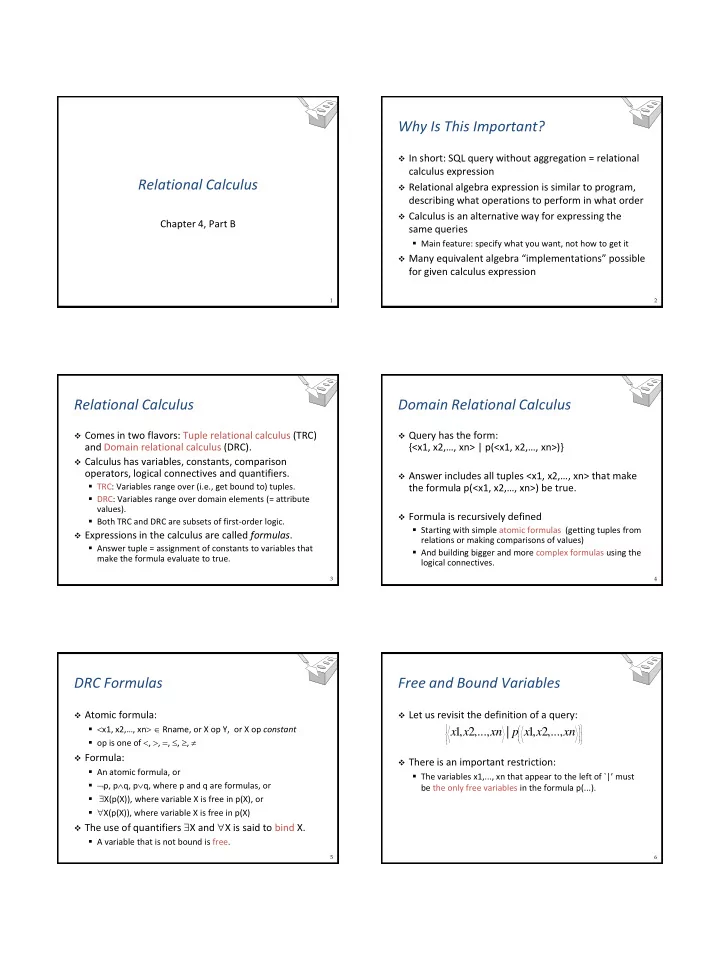

Why Is This Important? In short: SQL query without aggregation = relational calculus expression Relational Calculus Relational algebra expression is similar to program, describing what operations to perform in what order Calculus is an alternative way for expressing the Chapter 4, Part B same queries Main feature: specify what you want, not how to get it Many equivalent algebra “implementations” possible for given calculus expression 1 2 Relational Calculus Domain Relational Calculus Comes in two flavors: Tuple relational calculus (TRC) Query has the form: and Domain relational calculus (DRC). {<x1, x2,…, xn > | p(<x1, x2,…, xn>)} Calculus has variables, constants, comparison operators, logical connectives and quantifiers. Answer includes all tuples <x1, x2,…, xn> that make TRC: Variables range over (i.e., get bound to) tuples. the formula p(<x1, x2,…, xn>) be true. DRC: Variables range over domain elements (= attribute values). Formula is recursively defined Both TRC and DRC are subsets of first-order logic. Starting with simple atomic formulas (getting tuples from Expressions in the calculus are called formulas . relations or making comparisons of values) Answer tuple = assignment of constants to variables that And building bigger and more complex formulas using the make the formula evaluate to true. logical connectives. 3 4 DRC Formulas Free and Bound Variables Atomic formula: Let us revisit the definition of a query: x1, x2,…, xn Rname, or X op Y, or X op constant 1 , 2 ,..., | 1 , 2 ,..., x x xn p x x xn op is one of , , , , , Formula: There is an important restriction: An atomic formula, or The variables x1,..., xn that appear to the left of `|’ must p, p q, p q, where p and q are formulas, or be the only free variables in the formula p(...). X(p(X)), where variable X is free in p(X), or X(p(X)), where variable X is free in p(X) The use of quantifiers X and X is said to bind X. A variable that is not bound is free. 5 6
Find sailors rated > 7 who have reserved Find all sailors with a rating above 7 boat #103 , , , | , , , Sailors 7 I N T A I N T A T Condition I,N,T,A Sailors ensures that the domain , , , | , , , Sailors 7 I N T A I N T A T variables I, N, T and A have to be fields of the same Ir , Br , D Ir , Br , D Reserves Ir I Br 103 Sailors tuple. The term I,N,T,A to the left of `|’ (which should be read as “such that”) says that every tuple I,N,T,A We have used Ir,Br,D (…) as a shorthand for that satisfies T>7 is in the answer set. Ir ( Br ( D (…))) Modify this query to answer: Note the use of to find a tuple in Reserves that Find sailors who are older than 18 or have a rating under `joins with’ the Sailors tuple under consideration. 9, and are called ‘Joe’. 7 8 Find sailors rated > 7 who’ve reserved a Find sailors who’ve reserved all boats red boat Sailors , , , | , , , I , N , T , A | I , N , T , A Sailors T 7 I N T A I N T A Ir , Br , D Ir , Br , D Reserves Ir I , , , , Boats B BN C B BN C , , , , Boats ' red ' B BN C B BN C B Br C , , , , Reserves Ir Br D Ir Br D I Ir Br B Observe how the parentheses control the scope of Find all sailors I such that for each 3-tuple B,BN,C each quantifier’s binding. either it is not a tuple in Boats or there is a tuple in This may look cumbersome, but with a good user Reserves showing that sailor I has reserved it. interface, it can be very intuitive. (MS Access, QBE) 9 10 Find sailors who’ve reserved all boats Unsafe Queries, Expressive Power (again) It is possible to write syntactically correct calculus Sailors , , , | , , , I N T A I N T A queries that have an infinite number of answers. Such queries are called unsafe. , , Boats B BN C E.g., {S | (S Sailors)} , , Reserves Ir Br D I Ir Br B Theorem: Every query that can be expressed in relational algebra can be expressed as a safe query in Simpler notation, same query. (Much clearer) DRC / TRC The converse is also true. To find sailors who’ve reserved all red boats: Relational Completeness: Query language (e.g., SQL) can express every query that is expressible in ' red ' , , Reserves C Ir Br D I Ir Br B ... relational algebra/calculus. 11 12
Summary Relational calculus is non-operational Users define queries in terms of what they want, not in terms of how to compute it. (Declarativeness.) Algebra and safe calculus have the same expressive power, leading to the notion of relational completeness. Relational calculus had big influence on the design of SQL and Query-by-Example 13
Recommend
More recommend